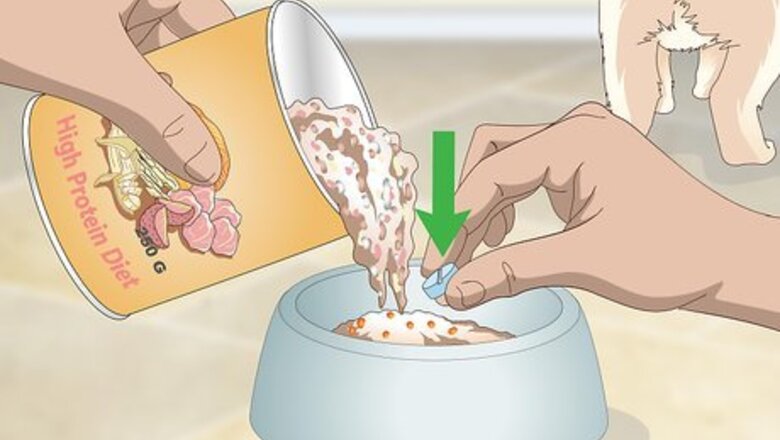
views
Sneaking in a Whole Pill
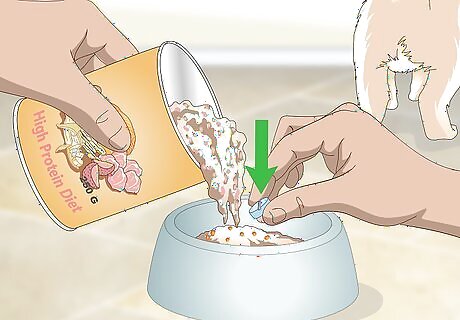
Slip the pill into your dog's favorite wet food if it eats fast. If your dog has a hearty appetite and usually makes short work of a bowl of food, hide the pill in wet food, or a combination of wet and dry. This may be all it takes to trick the dog into eating the pill, but be sure to check the bowl and the surrounding area to make sure the dog didn't spit the pill out. If your dog is a slow or finicky eater, it will likely eat around a pill buried in its food, so you'll probably have to hide it better. Give your dog a smaller portion than normal to ensure it eats all of the food and doesn't accidentally leave the pill behind. If you have more than one dog, make sure the other dogs aren't around so they don't accidentally eat the medication.
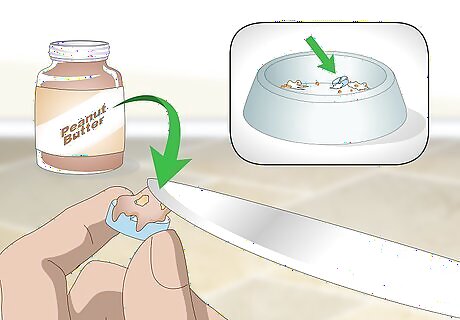
Coat the pill in peanut butter if it notices medicine in its food. If your dog won't eat pills hidden in its regular food, it's time to break out the snacks. Get a spoonful of regular or crunchy peanut butter, press the pill into the center, and roll it into a ball. Then, give the peanut butter ball to your pup! Make sure the peanut butter doesn't contain any xylitol, an artificial sweetener which is toxic to dogs. Other soft foods you can use to coat the pill include cream cheese, plain pumpkin, almond butter, and ice cream.
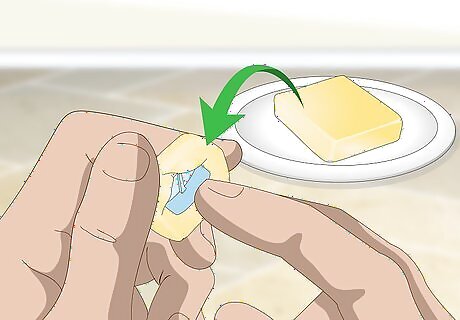
Wrap the pill in cheese or other snacks if you need to be sneakier. If coating the pill in a soft treat doesn't work, you might need to hide the pill in a sturdier snack. You could try wrapping the pill in a slice of cheese, for instance. You could also wrap the treat in a slice of meat that your dog likes, like turkey breast. Ask your vet if the pills are okay to be taken with dairy if you use cheese. Try offering the dog a few bites of the snack without the pill so it won't be suspicious. Do not use foods that are toxic to dogs, like chocolate, grapes, raisins, or foods containing onions or garlic. EXPERT TIP Ray Spragley, DVM Ray Spragley, DVM Veterinarian Dr. Ray Spragley is a Doctor of Veterinary Medicine and the Owner/Founder of Zen Dog Veterinary Care PLLC in New York. With experience in multiple institutions and private practices, Dr. Spragley’s specializations and interests include non-surgical management of cranial cruciate ligament tears, Intervertebral Disk Disease(IVDD), and pain management in osteoarthritis. Dr. Spragley holds a BS in Biology from SUNY Albany and has a Doctor of Veterinary Medicine degree (DVM) from Ross University School of Veterinary Medicine. He is also a Certified Canine Rehabilitation Therapist (CCRT) through the Canine Rehab Institute as well as a Certified Veterinary Acupuncturist (CVA) through Chi University. Ray Spragley, DVM Ray Spragley, DVM Veterinarian Hide medication in appealing dog foods. To encourage swallowing pills whole, you can hide them in common foods dogs love including chicken, cheese, or peanut butter. You can also gently place pills at the very back of the throat while holding the muzzle closed until they swallow. Another option is to ask your vet about compounding stubborn meds into appetizing liquid or chewable forms.
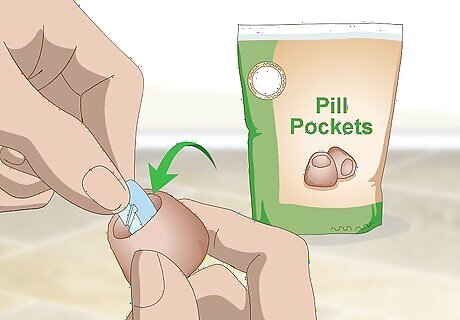
Buy "pill pockets" if you're looking for a commercial option. If you're busy or you just don't like the idea of squishing food around in your hands, you can buy special pill pockets, or treats which are made specifically for hiding pills. Just press the pill into the pocket and fold the treat over, then administer to your dog! You can find these at most stores which sell pet supplies.
Crushing the Pill
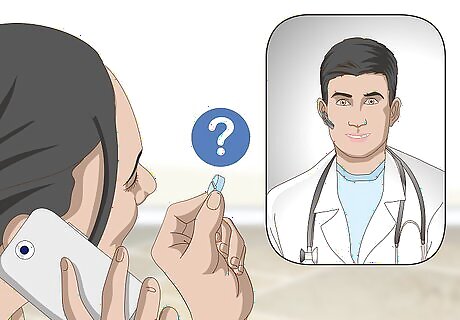
Ask your vet if the medication can be crushed. Some medications need to stay in pill form so they'll dissolve at the right pace. Also, if a pill has a coating, it's best not to crush it, since the coating is there to mask a bitter taste, and crushing the pill will just release more of that bitter flavor for your dog to smell and taste. If your vet says it's okay to crush the pill, you can proceed. Otherwise, try another option.
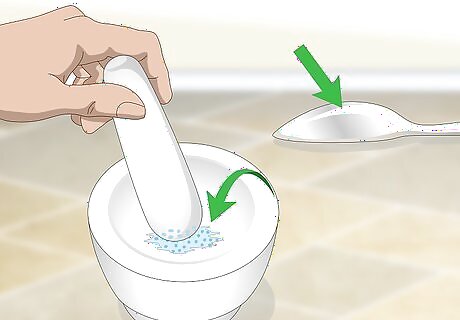
Crush the pill with a mortar and pestle or the back of a spoon. You can use whatever's on hand to crush the pill into a fine powder; just make sure whatever you choose isn't used for anything else. You don't want to accidentally get residue on something you're preparing for your family. If you crush the pill with a dish that you do need to re-use, be sure to wash it very well with soap and water.
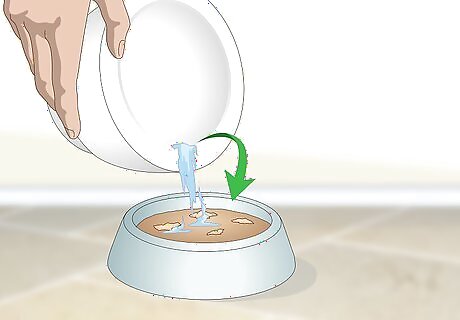
Mix the powder into a small amount of food with a strong taste. Dogs have a very sensitive sense of smell, so if you don't mask the scent and flavor of the crushed pill, your dog isn't likely to eat the food. Try hiding the powder in a rich, meaty gravy, or a sweet treat like applesauce. You could also mix the powder into ice cream, peanut butter, cheese, or anything else your dog loves!
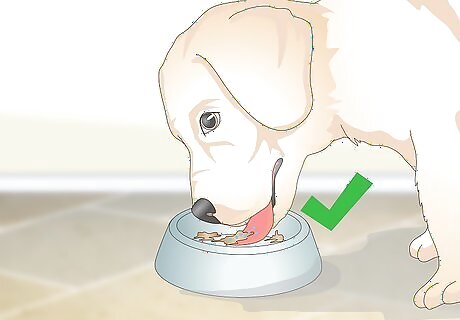
Make sure your dog eats all the food at once. Whatever you use to hide the powder, make sure it's a small enough portion that your dog will eat the whole thing at once. You don't want half of the medicine left behind just because your dog got full. If you have other dogs, it's a good idea to keep them out of the room so they can't eat any of the medicine.
Pushing a Pill into the Dog's Mouth
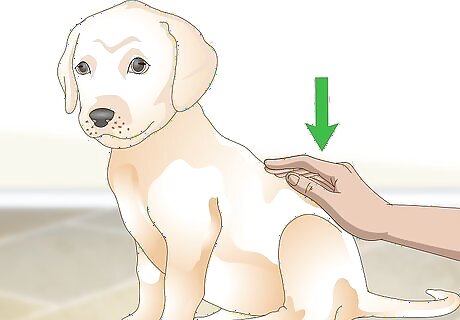
Have the dog sit. Getting your dog to swallow a whole pill is hard, and most dogs are resistant to the process. If you do want to try to do this, have the dog sit, and try to wait until it's calm and relaxed before you proceed. If try to hold your dog down when it's nervous, you'll create a negative association and it will be harder to get it to take its medicine next time.
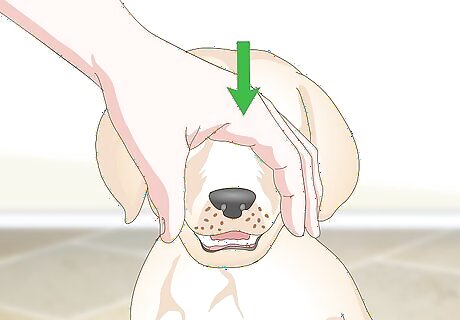
Hold your dog's upper jaw in your non-dominant hand. Hold your hand in a U-shape, and hold one side of the dog's snout firmly in place with your thumb, and the other side with your other fingers. This grip will give you the most control. Speak in a reassuring voice to your dog so it will stay relaxed through this process. If you have a very small dog, you may be able to hold it still by cupping its head in your palm rather than using your fingers.
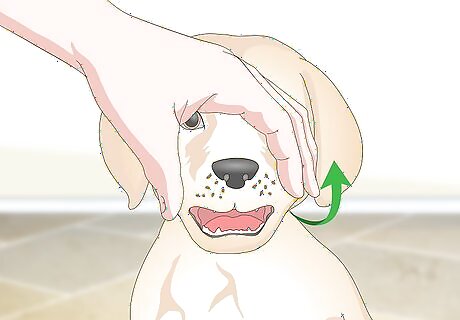
Tilt the dog's head back gently so its mouth will open. You want the dog to be relaxed with its mouth slightly open. The dog's head should still be mostly horizontal, which will leave its throat open and make it less likely to choke on the pill or be able to spit it out. The dog's mouth doesn't have to be open wide enough for the pill yet.
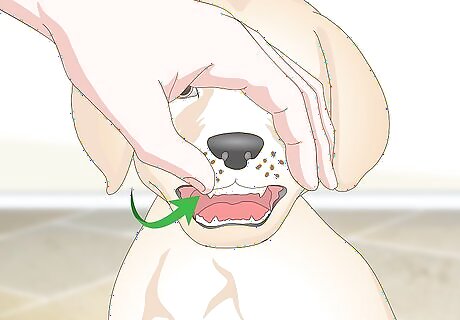
Use your fingers to push the dog's upper lip over its teeth. As you're holding the dog's head, slip your fingers into its mouth, gently rolling its upper lip over its canines. If the dog bites down while you're giving it the pill, it will bite its own lip and not your hand. In addition, having your fingers in the dog's mouth will help you have better control.
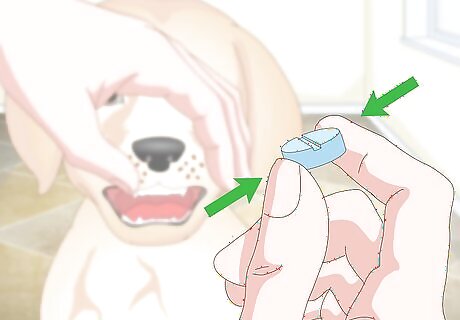
Hold the pill between the thumb and index finger of your other hand. Grab the pill in the hand you're not using to hold the dog's head. At this point, the dog might be getting antsy, so you'll need to work quickly. Continue reassuring the dog in a soft, calm voice to keep it from getting uneasy. If the dog is pulling away from you or showing the whites of its eyes, this method may not work. If you start to feel like the dog may be afraid, stop and try a different technique so you don't get bitten.
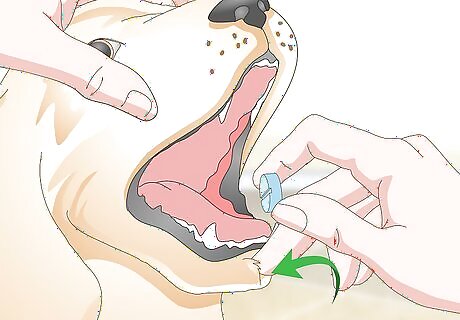
Use the middle finger of your dominant hand to pull the dog's jaw open more. With the pill help firmly between your thumb and index finger, use your middle finger to gently coax the dog's lower jaw down. The best way to do this is by pressing in and down on the outside of the dog's chin. Placing your finger inside the dog's mouth increases your chances of being bitten.
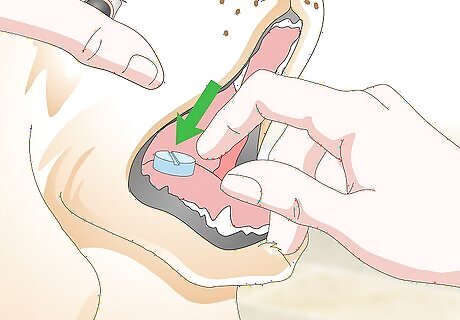
Drop the capsule as far back over the dog's tongue as you can. As soon as the dog's mouth is open wide enough for the pill to go in, use your thumb and forefinger to push the pill back into the dog's mouth. Your fingers will be inside of the dog's mouth for a moment, so be as quick as you can and hold the dog firmly so it doesn't bite down. You can also use a pill popper to drop the pill into the dog's mouth. A pill popper is a small device similar to a syringe, but it's designed to shoot a pill forward a short way. Just place the pill inside of the pill popper and place the tip inside the dog's mouth, then press the plunger firmly. This is especially helpful if the dog has a history of snapping or biting.
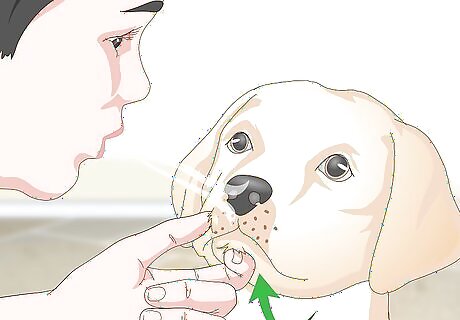
Push the dog's mouth closed and blow on its nose so it will swallow. Pull your hands away from the dog's mouth, but stay close to see if it swallows the pill. Blowing air in your dog's face will encourage it to swallow, which should get the pill down. If the dog does swallow the pill, give it a lot of praise, and consider giving it a treat so it will associate taking medicine with doing something good!
Giving Your Dog Liquid Medication
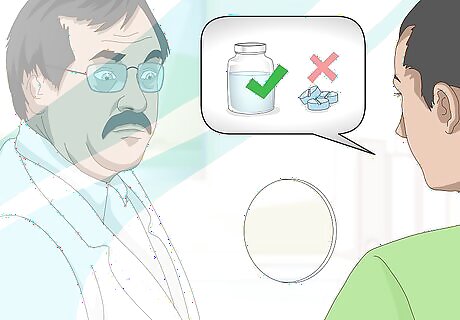
Ask your pharmacist to prepare a liquid medication if your dog hates pills. Some medications come in liquid form. However, if your dog's medicine comes in a pill and your dog won't take it, your pharmacist may be able to make a liquid suspension that you can give your dog instead. You may also be able to crush up a pill and mix it with about 1 fl oz (30 mL) of water. However, you should ask your vet if it's okay to crush the pill first.
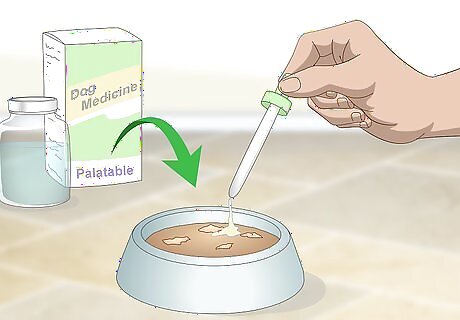
Add the required dosage to your dog's regular food if it's palatable. Some liquid medications are made to be palatable, meaning they have a pleasing flavor that your dog will enjoy. The label may say something like, “Palatable,” “Great taste!” or “Improved flavor!” If that's the case, you can just measure out the required dose and add it to your dog's regular food or to a treat. Try mixing the medication into foods like cheese, applesauce, or peanut butter. Make sure your dog eats the whole portion of food at once so the medicine isn't wasted.
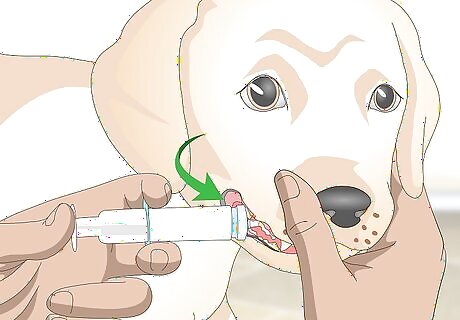
Use a syringe if the medicine has an unpleasant taste. If your dog won't eat the food containing its medicine, measure a dose into a plastic syringe, such as the kind used to give small children their medicine. Hold the dog's snout firmly in one hand, then slip the tip of the syringe into the pouch between the dog's cheek and its teeth. Once the syringe in place, press the plunger to squirt the medication toward the back of the dog's cheek. Once you've administered the medicine, remove the syringe and stroke the dog's cheek and throat until it swallows Do not tilt the dog's head back when you do this, as it could cause the dog to inhale the liquid into its windpipe.

















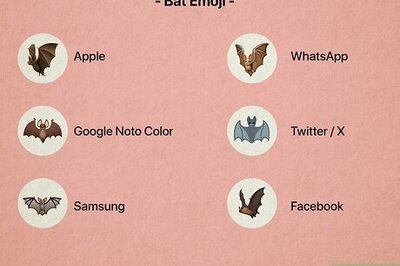


Comments
0 comment